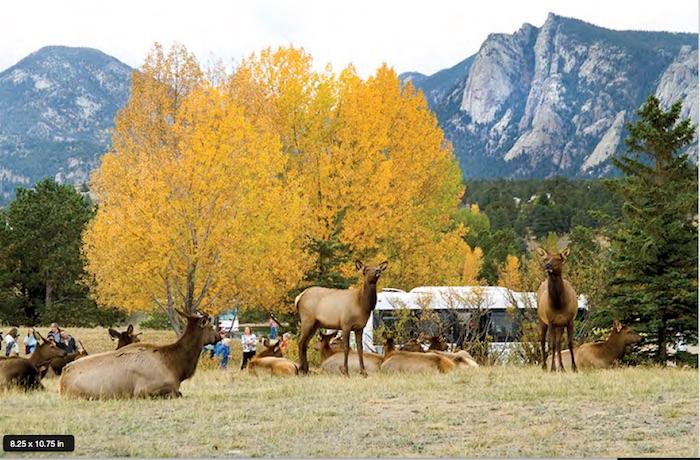Editor's note: The following is advertiser-sponsored content from Traveler's Essential Park Guide, Fall 2016.
Rocky Mountain National Park elk are not shy about posing for you. Indeed, they are the ubiquitous ambassadors for the park, and appear seemingly everywhere, at any time.
One summer, not too many years ago, the elk were browsing the vegetation just off the shoulder of Trail Ridge Road, and crossed the road right in front of me near the roof of the park. Two youngsters pranced around Horseshoe Park, and a cow and calf paralleled my path to Emerald Lake.
They say elk are highly social, but I figured that was among their own kind, not us humans. However, elk weren’t always this plentiful in Rocky Mountain National Park.
Heavy hunting during the late 1800s drove the species nearly to extinction. In 1913, determined to see the species rebound, the Estes Valley Improvement Association and U.S. Forest Service were able to negotiate the transplant of 49 Yellowstone National Park elk, and they quickly settled in. Two years later, Rocky Mountain National Park was established, and the growing elk herds were safe from hunters.
While I found elk just about everywhere during my summer visit to Rocky Mountain National Park, the best season, when it comes to these animals, is during fall, peaking in October—or, in Estes Park, officially declared “Elktober.”
Autumn is when the massive bull elk are driven to spread their genes during the rut, or mating season. It’s a noisy, raucous show (with sounds, sights, and smells) as the males compete for females. Their haunting, eerie, bugles echo throughout the alpine valleys every morning and evening (in places such as Horseshoe Park) as the males try to entice females.
“Bull elk signal the mating season with a crescendo of deep, resonant tones that rise rapidly to a high-pitched squeal before dropping to a series of grunts,” park biologists say. “The elk bugle gave rise to the term ‘rut’ for the elk mating season. ‘Rut’ is derived from the Latin word meaning roar. The eerie call echoes through the autumn nights and serves to intimidate rival males. Mating season is a stressful time for the animal, and the bugle may also act as a physical release of tension.”
And they get physical too, sparring with each other, displaying their huge sets of antlers. To conserve energy, biologists report, the bulls will also engage in less-demanding courtship activities to attract cows, such as flaunting their large bodies and racks, emitting strong, musky odors and bugling.
They are focused on the next year’s progeny, while Rocky Mountain National Park visitors are focusing on their showmanship. The residents of Estes Park commemorate this during the first weekend of October with the annual Elk Fest celebration. During this two-day affair there are self-guided tours; live music; Native American music and dancing; and elk-themed vendors and educational programs. The event culminates on Sunday with an amateur bugling contest allowing all ages to try their hand at emulating the wild call of the bull elk.

Elk abound in Estes Park and Rocky Mountain National Park and make wonderful photographic focal points against the golden aspen and mountains/O’Hara Photograpy
Throughout the rut—typically September and October—elk-centered tours and programs are offered. The Rocky Mountain Conservancy leads elk tours, the Estes Park Trolley features special tailgating tours, and the park offers plenty of elk-watching programs.
Or go on your own. Locally dubbed ‘tailgating’, roadside picnics can be gathered in the Estes Park village before heading into the park or the outskirts of town. Local delis and craft beverage houses offer unique food and drink, including (forgive us, please) elk summer sausage or jerky, to create the perfect spectator spread.
If you head out on your own, bring a chair and binoculars, sit back, watch, and listen to elk in Horseshoe Park, Moraine Park, and Upper Beaver Meadows. Park officials also recommend that you look for elk along the edges of clearings early in the morning or in the evenings, with mornings offering more solitude.
To minimize impacts to the animals, and to ensure a pleasant experience for visitors, park officials ask that you observe these viewing guidelines:
• Turn off car lights and engine immediately. Shut car doors quietly and keep conversations to a minimum.
• Observe and photograph the elk from a distance. If the elk move away or if their attention is diverted, you are too close.
• Stay by the roadside while viewing elk in park meadows. Travel is restricted to roadways and designated trails, and be aware of posted area closures.
• It is illegal to use artificial lights or calls to view or attract wildlife.
And, don’t forget your camera. The golden aspen, yellow cottonwoods, and the green conifers make great backdrops for a bugling elk, or battling bulls, in the foreground. A spotting scope can help with closeup shots, or searching for migrating birds. Take a break from elk watching and see if you can spot the colorful Western tanagers, which migrate through the park in early fall.
Weekdays offer higher elk-to-people ratios; fall visitation to the park is 50 percent heavier on weekends than weekdays. Elk-themed packages can be found online with many of Estes Park’s unique lodges, so a little planning can really help you make the most of your stay.
By the end of Elktober, you’ll have found another season to love in Estes Park.





